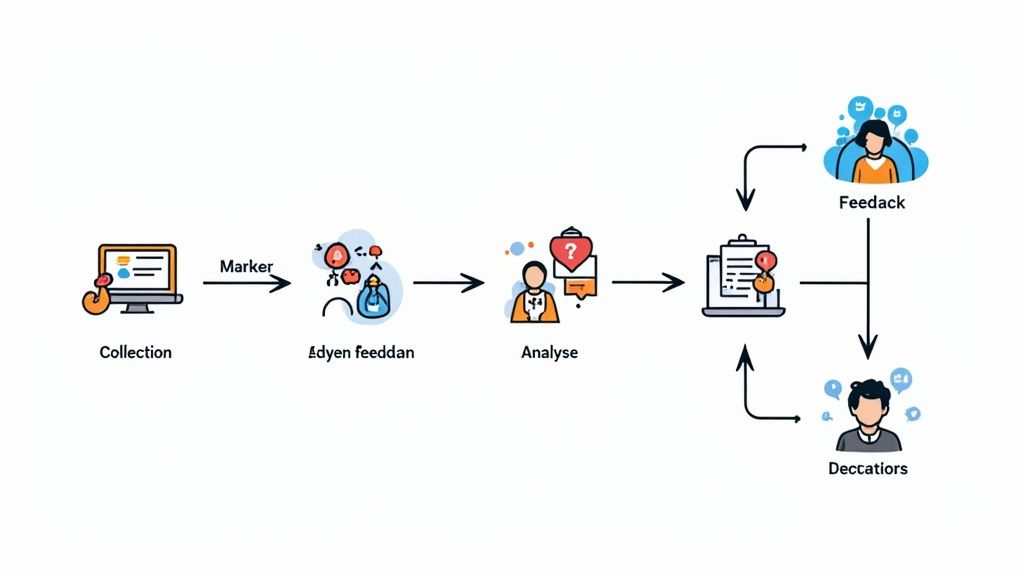Smart companies know that customer feedback management is crucial for success. Collecting and analyzing what customers say is essential for making good business decisions. Companies are working to create strong feedback programs to gather valuable customer insights.
The Impact on Revenue and Loyalty
Good feedback management directly affects a company’s bottom line. It helps increase customer retention, reduce customer loss, and boost lifetime value. Satisfied customers tend to buy more and recommend businesses to others. Quick responses to negative feedback help prevent customers from leaving and protect the company’s reputation. Using feedback management tools like Supportman helps businesses quickly act on customer input to improve satisfaction and loyalty.
Gaining a Competitive Edge
Companies that listen to customer feedback have real advantages. Understanding what customers want helps create better products and services. This sets them apart from competitors and helps win more business. Customer feedback also spots problems within the company, leading to smoother operations and better experiences.
Research shows growing interest in feedback management. The customer experience management market was worth USD 9,350 million in 2022. Experts predict it will grow 15.53% yearly from 2023 to 2032. Studies show that 83% of companies focusing on customer satisfaction see higher revenue, proving feedback management’s direct business impact. Learn more at Customer Experience Management Statistics.
Moving Beyond Basic Metrics
Modern feedback management involves more than just satisfaction scores. Companies now gather input from every customer touchpoint and use it to make real improvements. This means finding patterns in feedback data, understanding how customers feel, and making smart choices about products, service, and marketing. This complete approach helps build genuine customer relationships. Making feedback management a priority is key for long-term business growth.
Building a Modern Feedback Management Ecosystem

Customer feedback management systems have come a long way from basic surveys. Companies now use advanced tools to capture valuable customer insights and turn them into actionable improvements. This shift has changed how businesses connect with their customers and put data to work.
Automating Collection and Analysis
Smart companies now combine automated feedback tools with real-time analytics to get faster, deeper insights. This approach lets them gather feedback across channels – from website forms to social media – and analyze it instantly. For example, Supportman connects feedback directly to tools like Slack, enabling quick responses to customer needs. By automatically categorizing feedback, teams can spot trends and generate useful reports more efficiently.
Integrating for a Complete Picture
Modern feedback systems work smoothly with other business tools like CRM and marketing platforms. This creates a complete view of each customer by connecting their feedback to other key data points. Companies can then group customers based on their feedback and customize their support and offerings to match specific needs.
The feedback management software industry continues to grow rapidly. Market projections show it reaching $17.3 billion by 2028, with 11.7% yearly growth. These tools help businesses collect and analyze customer surveys systematically, leading to better decisions and improved customer experiences. Learn more from the Feedback Management Software Market report.
Selecting the Right Features
When choosing a customer feedback management system, focus on features that match your goals. AI-powered sentiment analysis helps understand customer emotions automatically, while predictive analytics uses past data to spot future trends. But remember – pick features based on what will give you the most valuable insights for your specific business needs.
Transforming Raw Feedback into Strategic Intelligence
Success in modern customer service requires going beyond basic data collection. By properly analyzing customer feedback, companies can uncover valuable insights and patterns that inform smarter business decisions. The key is understanding not just the surface-level feedback, but the deeper context and meaning behind what customers are expressing.
Uncovering Hidden Patterns with Advanced Analytics
Leading companies use a mix of analytical tools to gain deeper understanding from customer feedback. For example, sentiment analysis examines the emotional nuances in customer comments, going beyond basic positive/negative categorization to detect subtle shifts in customer feelings and emerging concerns.
Word frequency analysis helps identify key themes by tracking commonly used terms and phrases. If multiple customers suddenly start mentioning “delivery delays,” that signals a potential issue needing attention. This allows teams to spot and address problems early.
Implementing Effective Analysis Methods
The most valuable insights come from using multiple analysis approaches together. Sentiment analysis helps categorize the emotional tone of feedback, while frequency analysis shows trending topics. Teams also track changes in metrics like NPS scores over time to spot important patterns. For more details on getting the most from your feedback data, check out The Ultimate Guide to Customer Feedback Data.
Choosing the Right Analytical Tools
Picking the right tools is crucial for effective feedback analysis. Your customer feedback system should provide flexible analysis features that match your business needs. Consider your team size and specific requirements when selecting tools. For example, some tools like Supportman integrate feedback directly into Slack for quick team access and response.
Predicting Customer Behavior and Driving Proactive Improvements
Smart companies use feedback analysis to anticipate and address customer needs. By studying patterns in historical feedback, teams can spot emerging issues early and take action proactively. This helps improve customer retention and product development. For instance, analyzing feedback about specific features helps ensure future updates better serve customer needs. Through systematic analysis, companies turn raw feedback into concrete actions that drive growth and customer satisfaction.
Implementing for Maximum Adoption and Impact

Getting a customer feedback management system up and running requires more than picking software. You need a solid strategy focused on getting your team to embrace and actively use the system. Think of it as a key business initiative rather than just another tech project to check off.
Building a Solid Foundation: Planning and Preparation
Good planning sets everything in motion. Start by identifying who needs to be involved, setting clear goals, and mapping out realistic timelines. For instance, getting input from your customer service reps early can highlight current pain points and needed improvements. When people feel heard from the start, they’re more likely to support the new system.
Driving Adoption Through Training and Engagement
Strong adoption depends on proper training and keeping people engaged over time. Your team needs to understand both the mechanics of using the system and why it matters for their work. Create clear training materials and provide ongoing help to boost usage. Share early wins to build momentum. Tools like Supportman, which brings feedback directly into Slack, can help by making feedback visible and actionable within tools people already use.
Measuring Success and Iterating for Improvement
Track key metrics to gauge how well your customer feedback management system is working. Look at things like customer satisfaction scores, time to resolve issues, and total feedback responses. Regular monitoring helps you spot what’s working and what needs adjustment. Create feedback loops about the system itself, using data and user input to keep making it better.
Managing Risks and Ensuring Long-Term Success
Plan ahead for potential bumps in the road by developing strategies to handle technical issues, resistance to change, and data security concerns. A solid risk management plan keeps implementation on track. Consider rolling out changes in phases to catch and fix problems before going full-scale. When you treat implementation strategically and focus on adoption, measurement, and risk management, you set up your feedback system to drive real business results.
Driving ROI Through Actionable Customer Insights

Getting feedback from customers is just the beginning. The real power of a customer feedback management system comes from taking those insights and turning them into concrete actions that boost your bottom line. This means learning to prioritize improvements, use resources wisely, and measure results. Let’s explore how leading companies use feedback to generate real business impact.
Prioritizing Improvements and Allocating Resources
Every piece of feedback matters, but some issues impact customer satisfaction and revenue more than others. An effective feedback system helps identify these high-impact areas. For instance, if many customers mention long wait times, addressing this should be your top priority over one-off issues. This focused approach puts resources where they’ll make the biggest difference. Tools like Supportman can help by automatically sorting feedback in Slack, making it simple to spot recurring issues.
Measuring the Impact of Feedback-Driven Changes
Showing the ROI of your feedback program requires clear metrics and consistent tracking. For example, after making changes based on website navigation feedback, monitor your conversion and bounce rates to see direct results. This data-based approach proves the program’s worth and guides future decisions.
Creating Sustainable Feedback Loops
A successful feedback program needs ongoing attention, not just one-time fixes. Building lasting feedback loops ensures steady progress. This involves regular feedback collection, trend analysis, changes, and measuring outcomes. When done well, this process builds customer focus into your company culture and drives growth. Supportman supports this by delivering weekly metrics in Slack, keeping the whole team connected to feedback.
Achieving Quick Wins and Long-Term Value
While long-term planning matters, quick wins build momentum and show early value. Fixing simple issues like unclear website text or checkout problems can boost customer satisfaction fast. These quick fixes, combined with plans for bigger challenges, create a balanced approach that maximizes your feedback system’s ROI. This shows the ongoing value of customer feedback and encourages more investment in customer experience improvements.
Preparing for the Future of Feedback Management
A strong customer feedback management system is essential for any business looking to succeed. As customers expect more personalized service and better experiences, companies need feedback strategies that can adapt and grow. Here’s what you need to know about where feedback management is headed.
Using AI and Machine Learning
AI and machine learning are changing how companies work with customer feedback. These tools can now analyze the feelings and emotions behind customer comments with impressive accuracy. Going beyond simple positive/negative sorting, AI spots subtle signs of frustration or dissatisfaction, even in neutral-sounding feedback. This helps companies catch and fix issues early, before they grow into bigger problems.
Getting Ahead with Predictive Analysis
Predictive analysis takes feedback to the next level by studying past data to spot future trends. Instead of just reacting to problems, companies can prevent issues before they happen. For example, these tools can identify which customers might cancel their service based on their feedback patterns. This proactive approach helps build stronger customer relationships.
Meeting Customers Everywhere
Today’s customers interact with companies across many different channels – from social media to mobile apps to in-store experiences. Modern feedback systems need to capture input from all these touchpoints to build a complete picture. This means connecting your feedback tools with other systems like your CRM and marketing platforms to track the full customer journey.
Key Steps for Future Success
- Add AI capabilities: Look for feedback systems that include sentiment analysis and predictive features
- Connect your tools: Make sure your feedback system works smoothly with your other business software
- Focus on speed: Use systems that deliver feedback instantly so you can respond quickly
- Keep improving: Regularly review and update your feedback process based on results and new trends
Want to improve your feedback management? Supportman connects directly with Slack to deliver real-time feedback and weekly metrics to your team. Try it free today – no credit card needed. Get started with Supportman.


